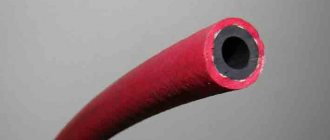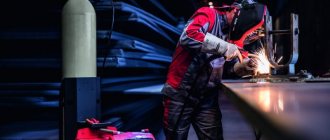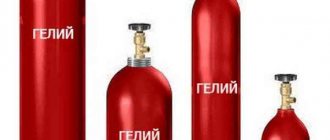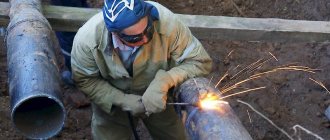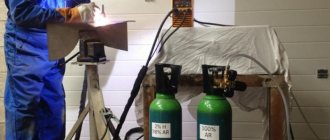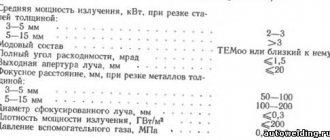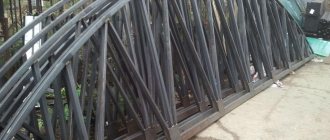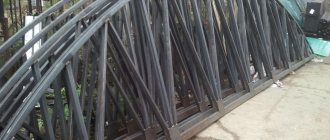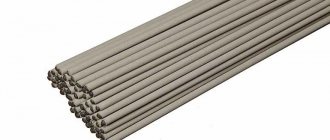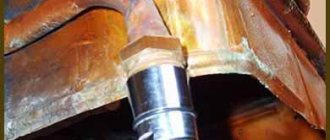Acetylene, hydrogen, natural gas and others are used as flammable gases for gas welding. Gas mixtures are also used for welding, such as petroleum gas, propane-butane gas mixture, and pyrolysis gas. In addition, gas welding uses vapors of flammable liquids - gasoline and kerosene.
The table shows the most common gases and gas mixtures for gas welding and gas cutting, indicating their main properties and scope of application:
Gas
| Density under normal conditions, kg/m2 | Heat of combustion under normal conditions, kJ/m3 | Flame temperature in a mixture with oxygen, °C | Acetylene replacement rate | Explosion limit (%) when mixed with: | Application area | ||
| air | oxygen | ||||||
| Acetylene | 1,09 | 529200 | 3200 | 1 | 2,2-81,0 | 2,3-93,0 | All types of gas welding |
| Hydrogen | 0,084 | 10080 | 2400 | 5,2 | 3,3-81,5 | 2,6-95,0 | For welding thin metal (up to 2mm), welding cast iron, aluminum, brass |
| Coke | 0,4-0,55 | 14700-18480 | 2000-2300 | 3,2 | 4,5-40,0 | 40,0-75,0 | For soldering, welding of low-melting metals, oxygen cutting |
| Oil | 0,87-1,37 | 36540-62160 | 2000-2400 | 3,0 | 3,8-24,6 | 10,0-73,6 | Same |
| Methane | 0,67 | 33600 | 2400-2700 | 1,6 | 4,8-16,7 | 5,0-59,2 | Same |
| Propane | 1,88 | 87360 | 2600-2800 | 0,6 | 2,0-9,5 | 2,0-48,0 | Soldering and welding of non-ferrous metals, gas cutting, welding of steels up to 6 mm thick, straightening, fire cleaning |
| Butane | 2,54 | 116760 | 2400-2500 | 0,45 | 1,5-8,5 | 2,0-45,0 | Same |
| Petrol | 0,7-0,76 | 42840 | 2400 | 1,4 | 0,7-6,0 | 2,1-28,4 | Gas cutting of steels, soldering and welding of low-melting metals |
| Kerosene | 0,82-0,84 | 42000 | 2300 | 1,6 | 1,4-5,5 | 2,0-28,0 | Same |
The choice of one gas or another for welding depends not only on the temperature of the flame, but also on the amount of heat (calorific value) that is obtained during its combustion. The acetylene replacement coefficient indicated in the table is the ratio of the replacement gas consumption to the acetylene consumption at the same effective thermal power. This coefficient is necessary if it is necessary to replace acetylene with another flammable gas.
Acetylene for gas welding
Acetylene is one of the most common gases used for gas welding. Acetylene has become most widespread due to the fact that the acetylene-oxygen gas flame has the highest temperature compared to other flammable gases and gas mixtures (see table above).
Acetylene is formed by the interaction of calcium carbide CaC2 with water. Calcium carbide is able to absorb moisture from the atmosphere and decompose under its influence. Therefore, it is stored in sealed steel roofing drums. The capacity of such drums is 100-130 kg. Calcium carbide is obtained by fusing coke and burnt lime in electric furnaces:
CaO + 3C = CaС2 + CO
Acetylene C2H2 is a chemical compound of carbon and hydrogen. To produce acetylene, acetylene generators are used, into which carbide and water are loaded. The chemical interaction of calcium carbide and water proceeds intensely, with a large release of heat Q:
CaC2 + 2H2O = C2H2 + Ca(OH)2 + Q
From 1 kg of calcium carbide you can get up to 300 liters of acetylene. Under normal conditions, acetylene is colorless and has a strong, specific odor. Acetylene is lighter than air, its density is 1.09 kg/m3.
Acetylene is explosive if it is mixed with air and its concentration is 2.2-81% by volume. When mixed with oxygen, acetylene is explosive at a concentration of 2.8-93% by volume. The most explosive are acetylene-oxygen mixtures containing 7-13% acetylene.
When dissolved in liquid, the explosiveness of acetylene is significantly reduced. In practice, acetylene is dissolved in acetone, 1 liter of which can dissolve up to 20 liters of acetylene. We talked about this in the article: “Gas cylinders for welding. Gas welding cylinders."
In addition to calcium carbide, sources of acetylene include natural gas, oil and coal. Acetylene obtained from natural gas is called pyrolysis acetylene.
Acetylene
Pure acetylene (C2H2) is colorless, with a pungent odor of garlic, leaving a sweetish taste in the mouth when inhaled. It is light (lighter than air) and quite harmful to humans. Acetylene can be obtained either on site (combining calcium carbide with water) or transporting it ready-made in gas cylinders. Calcium carbide is a solid crystalline substance formed by melting lime and coke at a temperature of 19002300C. For large volumes of work, it is beneficial to use acetylene generators; in other cases, it is convenient to take acetylene from cylinders. The advantages of this gas include a high combustion temperature, ease of production, and ease of regulation. The disadvantages include its explosiveness and considerable cost.
Acetylene substitutes
Substitute gases for C2H2 include propane and propane-butane mixture, hydrogen, coke oven gas, gasoline, and kerosene. They have fairly high calorific values. However, for high-quality work, more oxygen is required, and the flame t is still lower than that of acetylene. Therefore, propane, butane and other options are used more often in the manufacture of metal structures from non-ferrous, low-melting metals. It is difficult to join steel with them.
Hydrogen for gas welding
Hydrogen is a colorless, odorless gas. When mixed with oxygen or air, it forms an "explosive gas" which is explosive. Therefore, in the case of using hydrogen for welding metals, it is necessary to strictly adhere to safety rules during its storage, transportation and use.
Hydrogen is stored and transported in steel gas-welding cylinders at a pressure not exceeding 15 MPa. It can be obtained by decomposing water into hydrogen and oxygen using electrolysis. Hydrogen is also synthesized in special hydrogen generators by a chemical reaction of sulfuric acid H2SO4 and zinc or iron filings. In this case, zinc or iron sulfates are formed, and the released hydrogen accumulates inside the generator.
Selecting shielding gas for welding
Auto repair shop workers, installers and other welding specialists often use natural gas and various gas mixtures during welding. You will learn about what types of gases there are, their features and properties from our article. We will also provide recommendations on the selection and use of one or another shielding gas for different welding methods and depending on the material being welded.
Content
- Why do we need gases (protective) during welding and cutting?
- What types of gases exist for welding and cutting: their properties and application features
- Which gas to choose for a certain type of metal being welded
Why are shielding gases needed when welding and cutting?
Shielding gas is an important component that ensures productivity and decent quality of the welding process. The name of the shielding gas speaks for itself; it is needed to protect the hardening molten weld seam from oxidation, as well as from moisture and impurities in the air that can reduce the resistance of the seam to corrosion processes, lead to the appearance of pores and weaken the strength of the seam, affecting the geometry of the weld connections. In addition, the shielding gas cools the welding gun.
What types of gases are used for welding and cutting: their properties and application features
Inert and active gases, as well as their mixtures, are used as shielding gases used for welding.
1. Inert gases for welding . Inert gases are gases that are not capable of chemical reactions and are practically insoluble in metals. The atoms of such gases are endowed with outer electron shells filled with electrons, which explains their chemical inertness. These include argon, helium and their mixtures.
Argon ( Ar ) is an inert gas that does not enter into chemical reactions with molten metal and other gases in the arc combustion zone. The advantages of this inert gas include the fact that it is 38% heavier than air; argon displaces it from the welding zone and reliably isolates the weld pool from contact with the atmosphere. Most often, Ar is used as a shielding gas in the process of argon arc TIG welding and MIG/MAG welding. Examples of metals welded using argon and application features are given below in Table 1.
Argon is in demand as a shielding gas:
- in construction and mechanical engineering (when welding parts made of high-alloy steel; rapid cutting of metals, including thick sheets of refractory metals);
- in the mining industry and metallurgy (metal smelting; removal of gas inclusions from liquid steel).
Helium ( He ), like Ar, is chemically inert, but differs from it in that it is much lighter than air, which makes protecting the weld pool a more complex process that requires large amounts of shielding gas. Helium is used as an inert shielding gas during welding of stainless steels, non-ferrous metals and alloys, active and chemically pure materials. It provides increased penetration, and therefore is sometimes used to melt thick metal sheets or obtain a specially shaped weld. But due to the increased consumption and high cost of helium compared to argon, its scope of application is quite limited.
Helium (He) is used as a shielding gas:
- when welding stainless steels, non-ferrous metals and alloys, chemically pure and active materials.
1.1. Inert gas mixtures usually include argon and helium. Having a higher density than helium, such mixtures provide more reliable protection of the weld pool metal from air.
If it is necessary to weld chemically active metals, an inert mixture containing 60-65 vol. is often used. % He, 40-35 vol. %Ar. Inert gas mixtures are noticeably more expensive than pure argon, but provide a more intense release of heat from the electric arc at the welding site. This is significant for semi-automatic welding of metals characterized by high thermal conductivity.
2. Active gases for welding . These are gases that protect welding from air access and at the same time enter into chemical reactions with the metal being welded or physically dissolve in it.
Carbon dioxide ( CO2 ) (carbon dioxide) is a colorless, non-poisonous gas, soluble in water, and heavier than air. Carbon dioxide gas for welding should not contain mineral oils, glycerin, hydrogen sulfide, hydrochloric, sulfuric and nitric acid, alcohol, ethers, ammonia, organic acids and water. Due to the rarity of grade 1 welding carbon dioxide, grade 2 welding carbon dioxide and food grade carbon dioxide are used for welding. But, an increased content of water vapor in such carbon dioxide during welding leads to the appearance of pores in the seams and a decrease in the plastic properties of the welded joint.
In the welding process, solid carbon dioxide can also be used, corresponding to GOST 12162-66 of two grades - food grade and technical grade. When welding low-carbon and low-alloy structural steels, a gas mixture of carbon dioxide and oxygen (CO2 + + O2) is also used. Use a mixture that includes 30 vol. % oxygen. The mixture of CO2 + O2 has a more intense oxidizing effect on liquid metal, in contrast to pure carbon dioxide.
Carbon dioxide is used as a protective agent:
- in construction and mechanical engineering (electric welding; fine sharpening processes, cold fitting of machine parts)
Oxygen ( O ) is included in the gas mixtures CO2 + O2 and Ar + O2. It is a colorless, odorless gas that supports combustion. In case of cooling to a temperature of -183 degrees. Celsius, oxygen turns into a mobile blue liquid, and at a temperature of -219 degrees. Celsius freezes. Oxygen guarantees a very wide weld profile, characterized by shallow penetration, and also provides a high heat input to the metal surface. Oxygen-argon mixtures are distinguished by a special weld penetration profile, reminiscent of a “nail head”.
Oxygen as a protective gas is sometimes necessary:
- in construction and mechanical engineering (oxygen-acetylene gas cutting and gas welding of metals, surfacing and spraying of metals, plasma cutting of metals)
Hydrogen ( H ) is colorless, odorless, and flammable. Hydrogen is not suitable for martensitic or ferritic steels due to cracking, but can be used in concentrations of 30 to 40% for plasma cutting stainless steel to increase power and reduce slag.
- Hydrogen has found application in atomic hydrogen welding.
Nitrogen ( N ) is a colorless and odorless gas that does not burn and does not support combustion. In accordance with GOST 9293-59, nitrogen comes in four grades: electric vacuum, gaseous gaseous 1st grade, gaseous 2nd grade and liquid. The inclusion of nitrogen in these varieties must be, respectively, no less than vol.%: 99.5; 99.9; 99 and 96. The main impurity in each of them is oxygen.
Nitrogen is most often used as a shielding gas:
- when welding copper.
2.1. Mixtures of inert and active gases are increasingly used in the process of consumable electrode welding of steels of various classes due to their technological advantages. These include:
- high arc stability, favorable character of electrode metal transfer through the arc,
- the degree of chemical action on the metal surface of the weld pool is lower when compared with active gases.
The addition of a small amount of oxygen or other oxidizing gas to argon significantly increases the stability of arc combustion and improves the quality of formation of welded joints. Oxygen in the arc atmosphere provides fine-droplet transfer of the electrode metal.
Selecting a gas for a specific type of metal being welded
What gas is used when welding a particular metal is one of the most frequently asked questions for beginners in welding on thematic forums. Examples of the use of various shielding gases and gas mixtures for welding various metals are given in the table.
| Metal to be welded | Shielding gas used in welding | Features of the welding process |
| Carbon steel | 75% Ar+25% CO2 | High speed of the welding process without burning through metal up to 3 mm thick, minimum deformation and spatter formation |
| CO2 | Deep penetration, high welding speed | |
| Stainless steel | 90% He+7.5% Ar+2.5% CO2 | No oxidation of the welded metal and no burn-through, small heat-affected zone, |
| Low alloy steel | 60-70% He+25-35% Ar+4.5% CO2 | High impact strength, minimal reactivity, |
| 75% Ar+25% CO2 | Sufficient strength, small spatter along the contour of the welded joint, high arc stability. | |
| Aluminum and its alloys | Ar | Stable arc and excellent transfer of electrode material during the welding process of thick parts. up to 25 mm |
| 35% Ar+65% He | Greater heat input compared to welding with pure argon, improved fusion characteristics, used when welding thick metal. 25- 76 mm | |
| 25% Ar+75% He | Maximum heat input, low porosity, used when welding metal over 76 mm | |
| Magnesium alloys | Ar | Impeccable seam quality (cleanliness) |
| Stainless steel | Ar-1%O | Improved arc stability, good weld bead fusion, more fluid controllable weld pool, minimal burn-through when welding heavy stainless steels |
| Ar+2% O | Stable arc, fusion and welding speed than 1% oxygen, used for welding thin stainless steels | |
| Carbon steel | Ar+1-5% O | Improved arc stability, excellent weld bead contour fusion, more fluid controlled weld pool, minimal burn-through, faster welding speed compared to pure argon welding |
| Ar +3-10% | Beautiful weld seam, welding only with electrode positioning, minimal spatter formation | |
| Low alloy steels | Ar+2% O | Low risk of burn-through, weld strength |
| Titanium | Ar | Good arc stability |
| Copper, nickel and their alloys | Ar | It is characterized by good fusion, reduced metal fluidity, and is used for welding thick metal. up to 3 mm |
| Ar+80-75% He | Characterized by increased heat input | |
| Copper, duplex steel | ||
| N | Demanded for protecting the root of the seam. Reduces the formation of oxide films at the root of the weld |
By correctly determining the type of shielding gas, you will ensure the efficiency and quality of welding, as well as guarantee an excellent welded joint and penetration depth, increase the reliability of the created seam and the quality of the part. The selection of a suitable shielding gas and its quality significantly influence the consumption of welding consumables, the labor of the welder and the correction of defects and the final processing of the weld joint.
If you have any questions on the topic, we recommend that you find the most up-to-date information on our website, or directly contact Tiberis consultants.
Petroleum gas, natural gas and propane-butane mixture for gas welding
Pyrolysis gas is a mixture of flammable gases formed during the breakdown of oil, fuel oil and other petroleum products when exposed to high temperatures. Pyrolysis gas contains sulfur compounds, which cause corrosion of mouthpieces in gas welding torches. Therefore, this gas undergoes thorough purification before use.
Petroleum gas is a by-product of oil refineries. It is mainly used for cutting and welding thin metals and for welding non-ferrous metals.
Propane-butane mixtures are colorless and odorless mixtures. They consist of propane C3H8 and butane C4H10. This mixture has the highest calorific value, i.e., when it burns, the greatest amount of heat is released.
What types of gas torches are used for welding
A gas torch is an important and rather complex element of welding equipment, although at first glance it is not one. It is necessary to obtain a torch that affects the metal and helps regulate the volume and power of the flame within certain limits.
The designs of gas burners are divided into:
- injection;
- non-injector.
Based on the type of gas used, they are divided into:
- acetylene;
- for liquid fuels, as well as other gases.
According to the processing method they are divided into:
- manual,
- machine
1. Injector and non-injector types of torches for welding with gas.
The need to maintain the required level of supply gas pressure led to the burner being equipped with a jet pump. High gas pressure does not require turning on the pump, since the fuel is supplied at the required level. But if the gas is in cylinders under low pressure, then its consumption increases. In this case, the pressure is artificially increased. It is then that the feed is applied using an injector - forcibly. Then, in the welding chamber of the torch, oxygen is mixed with other gases until the required mixture is obtained, which creates a torch.
Simpler are burners that do not have an injector. Gases (oxygen and fuel) for the torch enter the mixer through a supply system. It includes: hoses, valves and nipples. The mixture for a high-quality flame becomes homogeneous already in the mixer.
It passes through the tip tube and is fed to the mouthpiece, then it is ignited, forming the flame necessary for work. You should carefully monitor the pressure parameters of the mixture supplied from the mouthpiece - this way you can regulate the combustion process. The speed at which the mixture of acetylene and oxygen escapes from the mouthpiece can be 70–160 m/sec. If it is insufficient, the mixture gets inside the burner and explodes in it. If it is too high, the torch comes off the burner and goes out.
High pressure burners can use methane and hydrogen. They are quite simple to operate, but are used much less frequently than low-pressure injection burners.
2. Low pressure burner operation.
The supply system (nipple and control valve) supplies high pressure oxygen (4 atm) to the burner. The gas flows at high speed through the injector. In the chamber of the jet pump, oxygen with its jet creates a reduced pressure (below atmospheric pressure), due to which flammable gas enters it. It passes through the nipple and valve, and then the injector, and mixes with oxygen in the mixing chamber. Then it is fed to the mouthpiece at the speed required for work.
During operation, oxygen consumption is constant, since it is not affected by external factors. The same cannot be said about acetylene, which is affected by pressure fluctuations, heating of the mouthpiece, and increasing resistance. Which leads to increased consumption.
Gases complementing welding mixtures
Thanks to such welding gases, it is possible to make a better quality weld and reduce metal spattering.
For MIG MAG welding, oxygen is used as an additional component. With its help, you can create a wide seam, while the penetration of the metal is insignificant.
Hydrogen is used to bond austenitic stainless steel. The process creates a wide seam with deep penetration.
Nitrogen is intended more to protect the weld from rust than as a protection.
It is very important to choose the right shielding gas. Not only the quality and geometry of the weld directly depends on this. This way, it will be easier to correct defects and process the seam at the end.
Helium for welding
Helium is a non-poisonous type of protective gas; it is odorless, tasteless and colorless. Helium is used for argon-arc TIG welding of non-ferrous metals, aluminum, etc. This option is also suitable for welding on ceiling surfaces. In the process, it is possible to obtain a wide weld with wetted edges.
Helium is often used in addition to argon. It is designed for joining magnesium and aluminum alloys, as well as active and chemically pure metals. This gas is found in brown cylinders and has a white lettering.
Carbon dioxide is suitable for welding thicker metals. In this case, you need to be prepared for the formation of splashes during welding. You can only work using a short arc. The gas is used for MAG flux cored wire welding and semi-automatic MAG short arc welding. Available for sale in black cylinders with yellow inscription.
Gas welding: what should the mixture be?
The efficiency of the welding process is affected by the state of the mixture catalyst, which is oxygen. The speed of work and the quality of the connecting seam depend on the degree of its purity.
To obtain an intense and maximum hot burner flame, it is necessary to use technically pure oxygen.
Influence of gas components on the characteristics of the welding process.
The influx of just such oxygen into the flame gives the latter excellent oxidation and reduction characteristics.
Meanwhile, the use of pure oxygen complicates the process in some way. In particular, mixing pure oxygen with some flammable gases makes them especially explosive because they burn too quickly. In addition, working with pure oxygen requires that it be stored in special cylinders, which creates additional inconvenience.
An alternative to this method is to use crude (atmospheric) oxygen. It is more explosion and fireproof, but welding operations using it are less effective. Since oxygen occupies no more than 20% of the volume in the surrounding air, the mixture of atmospheric gases cannot provide a very high combustion temperature. For this reason, the welding procedure slows down significantly.
Gas mixtures
For welding, 4 gaseous colorless substances are used, displacing them from the working area:
- hydrogen, which promotes embrittlement of metals;
- nitrogen, which forms solid slag compounds;
- oxygen, which actively oxidizes metals.
The displacement of gas-air components occurs due to the high density of protective gases; they form a sedentary cloud. All welding gas mixtures have a specific gravity greater than that of air. The concentration of components was selected experimentally, and the influence of gases on the welding mode was taken into account. Argon-based mixtures significantly expand welding capabilities and increase the efficiency of welders. Minimize the risk of defects in welding seams.
Argon and carbon dioxide
For welding non-ferrous metals, profiles and rolled high-alloy steels, a welding mixture of argon and carbon dioxide is used. Argon reduces the activity of carbon dioxide, and CO2 increases the heat transfer of argon. Welding carbon and low-alloy steels in a protective Ar+CO2 cloud is much more efficient than in each individual gas. With a carbon dioxide concentration of within 20%, thick-walled metal structures are boiled even when the surface is heavily contaminated.
Argon and oxygen
The composition is used for welding low-alloy and nickel-alloyed steels. With a low concentration of oxygen, it is possible to avoid porosity of the seams; argon prevents the formation of oxides. The Ar+O2 combination is used with various types of welding wire, expanding the capabilities of the welding process by increasing arc energy and stable combustion. The metal cooks faster. Smooth seam beads are formed with uniform heating of the filler rod. The strength of the connection increases due to the expansion of the diffusion layer.
Argon and helium
Inert gases are combined in different proportions. The most common compositions are 7:3 and 1:1. The Ar+He composition is used when working with various metals:
- cast iron of various densities;
- with low-alloy and alloy steels with high nickel and chromium content;
- non-ferrous alloys based on copper, aluminum;
- refractory workpieces.
Criteria and features of gas selection
The choice of the type of protective environment for semi-automatic welding is carried out on the basis of information about the type and grade of metal of the workpieces, which, in turn, indicates their physical and chemical characteristics. In the case of welding dissimilar materials, the less stable and/or more refractory is considered the main one. In addition, the following must be taken into account:
- Geometric parameters of workpieces and the method of their preparation for welding.
- Availability and type of heat treatment of workpieces.
- Technological features of the welding process , requirements for seam quality.
- Technical characteristics of the equipment and consumables used.
- External conditions, including : temperature, humidity, presence and strength of wind, ease of access to the joint.
- Economic indicators (cost and estimated gas consumption).
The table below shows popular types of metals, as well as gases and gas mixtures recommended as a protective environment for welding them.
| Material | Low carbon steel | Alloy steel, medium or high carbon | Aluminum and aluminum-containing alloys |
| Ar | Yes | Yes | Yes |
| He | No | No | Yes |
| CO2 | Yes | Yes, limited | No |
| Ar+CO2 | Yes | Yes | No |
| Ar+O2 | Yes | Yes, limited | No |
| Ar+He | No | Yes | Yes |
| Ar+CO2+O2 | Yes | Yes, limited | No |
| Ar+H2 | Yes, limited | Yes | No |
| Ar+He+CO2 | Yes | Yes | No |
| He+Ar+CO2 | No | Yes | No |
All of these gases are suitable for MIG and MAG welding; for the TIG method, argon or helium in pure form, as well as a mixture of them, are recommended. Sometimes when working with a consumable electrode, a mixture of argon and hydrogen is used. It is important to consider that the correct choice of shielding gas depends on:
- quality and neatness of the seam;
- work safety;
- financial and labor costs.
It is not allowed to change the protective environment during the welding process, even if it takes place layer by layer with complete crystallization. The gas supply should begin 15-30 seconds before ignition of the arc and end after the bath has solidified.
Welding equipment and active gas.
But to really achieve a good result, you need to choose the right shielding gas and welding equipment.
As for the first, we note that the most popular is carbon dioxide, as well as its mixtures, for example, with inert gases helium and argon. And welding is performed in active gases using semi-automatic welding machines that operate on pulsed or direct current.
In one of the articles we have already noted the advantages of such devices. Let us remind you that semi-automatic machines allow you to obtain high-quality seams, while the welding process itself takes place practically without splashes. In addition to these indicators, of course, it is worth noting the high performance of such devices.
